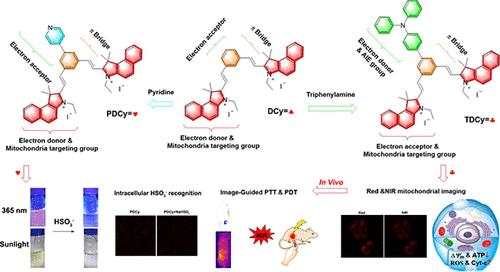半花青碱分子的构效关系:线粒体靶向半花青碱荧光分子探针用于HSO3识别和近红外图像引导光热/光动力协同治疗
IF 4.6
2区 化学
Q2 CHEMISTRY, PHYSICAL
引用次数: 0
摘要
半花青碱分子由于其优异的光学特性、细胞穿透性、潜在的线粒体靶向性和光敏性,在荧光传感、生物成像和疾病治疗领域具有无与伦比的潜力。本文研制了三种双阳离子半菁氨酸分子探针,分别为DCy、PDCy和TDCy。PDCy在365 nm紫外光或日光下均能识别HSO3 -。此外,TDCy是一种多功能分子,具有合成简单、红光和近红外双通道线粒体成像、光热/光动力协同治疗能力等优点。通过分析三种半花青素分子结构与HSO3 -识别、光敏性、光热活性、细胞成像和细胞毒性的相关性,可以总结出半花青素分子的构效关系,为后续的研究开发提供指导。本文章由计算机程序翻译,如有差异,请以英文原文为准。

Structure–Activity Relationship of Hemicyanine Molecules: Mitochondrion-Targeting Hemicyanine Fluorescent Molecular Probes for HSO3– Recognition and Near-Infrared Image-Guided Photothermal/Photodynamic Synergetic Therapy
Hemicyanine molecules have unparalleled potential in the fields of fluorescence sensing, bioimaging, and disease therapeutics due to their excellent optical properties, cell penetration, potential mitochondrial targeting, and photosensitivity. Herein, three dual-cation hemicyanine molecular probes named DCy, PDCy, and TDCy were developed. All of them could detect HSO3–, and PDCy could recognize HSO3– under 365 nm ultraviolet light or sunlight. In addition, TDCy is a multifunctional molecule, which has the following advantages: simple synthesis, red and near-infrared dual-channel mitochondrial imaging, and photothermal/photodynamic synergistic therapy capabilities. Upon analysis of the correlation between the structures of the three hemicyanine molecules and HSO3– recognition, photosensitivity, photothermal activity, cell imaging, and cytotoxicity, the structure–activity relationship of the hemicyanine molecules could be summarized, which could provide guidance for subsequent research and development.
求助全文
通过发布文献求助,成功后即可免费获取论文全文。
去求助
来源期刊

The Journal of Physical Chemistry Letters
CHEMISTRY, PHYSICAL-NANOSCIENCE & NANOTECHNOLOGY
CiteScore
9.60
自引率
7.00%
发文量
1519
审稿时长
1.6 months
期刊介绍:
The Journal of Physical Chemistry (JPC) Letters is devoted to reporting new and original experimental and theoretical basic research of interest to physical chemists, biophysical chemists, chemical physicists, physicists, material scientists, and engineers. An important criterion for acceptance is that the paper reports a significant scientific advance and/or physical insight such that rapid publication is essential. Two issues of JPC Letters are published each month.
 求助内容:
求助内容: 应助结果提醒方式:
应助结果提醒方式:


